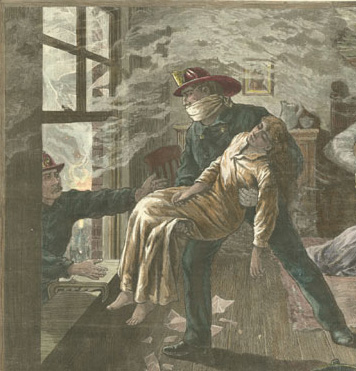


New York City was liberated from the British on November 25, 1783, though
both the city and its fire department remained in ruins because of the last
big fire. The city government proceeded to rebuild the department and replace
damaged equipment. By February 1786, the fire department had grown to include
of 300 men, 15 engine companies and 2 ladder companies, all of whom were
supervised by 5 engineers. Most of the firemen were new, as those who had
served under the British were punished for their disloyalty with dismissal
from their positions.
It was around this time that the fire department began a policy of allowing members to elect a foremen in each company rather than having one appointed by the Common Council, helping to give the department an identity separate from the rest of city government—a tradition of independence which would persist for decades to come. At first it was the foremen and engineers alone who formed the governing body of the department. In 1792, firemen, dissatisfied with this arrangement, began to demand their own voice in the department’s running. After a bitter and protracted fight, they got their way; it was decided that each company with eighteen or more volunteers was entitled to two representatives, and each company with fewer than eighteen members to one. Thereafter, the management of the department became a battle between the city council-appointed engineers and the democratically-chosen foremen and firefighters. Further asserting control over the structure of the department, firemen then organized a welfare insurance program for the families of those among their ranks who had been injured or killed. This widows and orphans fund was managed directly by the firemen.
Technological improvements in fire fighting equipment continued during the first decades of the nineteenth century. Water-tight hose connections were invented, making is possible for the first time to pump water directly from engine to engine and then directly onto the fire. A system of hydrants was built to replace the much more cumbersome bucket brigades. By the early 1820s, the department had grown to 1,200 men, 46 engine companies, 4 ladder companies and 1 hose company. To further professionalize their profession, fire fighters began to don a uniform which included red shirts, black caps, and suspenders. Firemen became so admired that boys and young men flocked to the scenes of fires to volunteer to assist their heroes. The fire department was poised to enter a new phase again as New York City grew immensely in the nineteenth century. As the city grew, the firefighters would be called upon to protect more and more property and people from destruction.